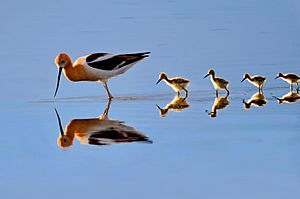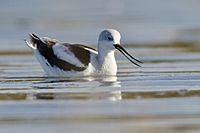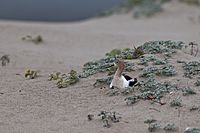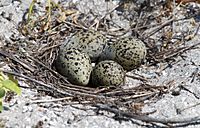American avocet facts for kids
Quick facts for kids American avocet |
|
|---|---|
 |
|
| Breeding plumage | |
| Conservation status | |
| Scientific classification | |
 |

The American avocet (Recurvirostra americana) is a large wader bird. It belongs to the avocet and stilt family, called Recurvirostridae. This bird spends a lot of its time looking for food in shallow water or on muddy areas. It often sweeps its long bill from side to side in the water. It does this to find small crabs and insects to eat.
Contents
About the American Avocet
The American avocet is a type of bird in the order Charadriiformes. This group includes many shorebirds, gulls, and alcids. Its family, Recurvirostridae, includes both stilts and avocets. There are four different species of avocets in the world. The American avocet is one of them. The others are the Andean avocet, the pied avocet, and the red-necked avocet.
What Does It Look Like?
The American avocet is about 40 to 51 centimeters (16 to 20 inches) long. Its wings can spread out 68 to 76 centimeters (27 to 30 inches) wide. It usually weighs between 275 and 420 grams (9.7 to 14.8 ounces).
Its bill is black, pointed, and curves slightly upwards. This bill is very long, more than twice the length of its small, round head. Like many waders, the avocet has long, thin legs and slightly webbed feet. Its legs are a light grey-blue color. This is why some people call it "blue shanks."
The bird's body feathers, called plumage, are black and white on its back. Its belly is white. During the time they lay eggs, called the breeding season, their head and neck turn a bright orange color. This color also goes down a bit onto their chest. After the breeding season, these bright feathers are replaced with white and grey ones. Avocets often clean their feathers. This is a natural way for them to stay comfortable and tidy.
Where Do They Live?
American avocets used to live all over the United States. However, they disappeared from the East Coast a long time ago. They like to breed in marshes, on beaches, near prairie ponds, and in shallow lakes. These places are mostly in the mid-western United States and southern Canada.
Their breeding areas are just east of the Rocky Mountains. This includes parts of Alberta, Saskatchewan, Montana, Idaho, Washington, Utah, North and South Dakota, Nebraska, Colorado, and even New Mexico, Oklahoma, and Texas. When winter comes, they fly to warmer places. Their travel path, called migration, takes them through almost every state in the western United States.
Their main winter homes are along the coasts. You can find them along the Atlantic Ocean in North and South Carolina, Georgia, and Florida. They also spend winter along the Gulf of Mexico in Florida, Texas, and Mexico. On the Pacific Ocean side, they are found in California and Mexico. Some groups of avocets live all year round in certain parts of Mexico and Central California.
Avocet Life and Habits
How They Communicate
The American avocet makes a sound that people describe as a sharp and musical alarm. It sounds like "bweet" and gets higher in pitch over time.
Raising Their Young
American avocets build their nests in wet areas, from fresh water to very salty lakes. They form groups to breed, sometimes with dozens of pairs together. During the breeding season, male and female birds pair up. They do special dances to find a mate. After breeding, the birds gather in large groups, sometimes with hundreds of birds.
They build their nests close to water, often on small islands or muddy shorelines. This makes it hard for animals that might eat their eggs or chicks to reach them. Both the male and female avocet work together to build a nest that looks like a shallow bowl. They take turns sitting on the four eggs to keep them warm. Once the chicks hatch, they can feed themselves right away. Their parents do not feed them.
What They Eat
American avocets prefer to find food in places with soft mud or sand. In the winter, they eat a lot of tiny creatures called brine shrimp. They usually walk or wade along the shore, pecking at the ground to find food. They can also swim to look for food in a wider area.
During the breeding season, avocets still eat brine shrimp. But they mostly switch to eating brine flies. Brine flies and their young are so common in avocet breeding areas that they can make the mud look black. These flies give the avocets the energy they need during this important time.
Avocets use both their eyes and their sense of touch to find food. When they use their eyes, they often peck at flies. They also plunge their head and neck underwater to catch food. Sometimes they snatch flying insects out of the air. They can also move their head along the water's surface, opening and closing their bill to catch things. When they use their sense of touch, they filter food from the water, scrape it from surfaces, or sweep their bill from side to side.
Dangers They Face
In the past, people hunted and trapped American avocets. This caused their numbers to drop a lot until the 1900s. Because of this, they disappeared from most of the East Coast of the United States. In 1918, a law called the Migratory Bird Treaty Act of 1918 was passed. This law made it illegal to hunt avocets, protecting them.
Since then, other dangers have appeared. Harmful chemicals like DDT, selenium, and methylmercury have greatly affected how well avocets can breed. Young avocet chicks are more sensitive to these environmental problems than adult birds. Avocets also face losing their homes. While some farms and factories have become new places for avocets to live, natural wetlands are disappearing quickly.

In Art
The famous artist John James Audubon wrote about the American avocet in his book The Birds of America. He described spending a day watching these birds very closely. He wrote down how they found food, built nests, defended themselves, and flew. You can see his painting of the avocet on the right.
Protected Status
The American avocet is a protected bird under the Migratory Bird Treaty Act of 1918. This law helps keep them safe.
Gallery
Images for kids
-
An avocet flying at the Sacramento National Wildlife Refuge, California.
See also
 In Spanish: Avoceta americana para niños
In Spanish: Avoceta americana para niños









